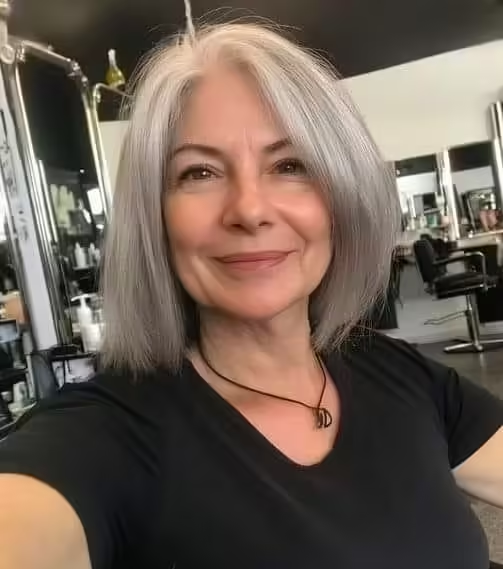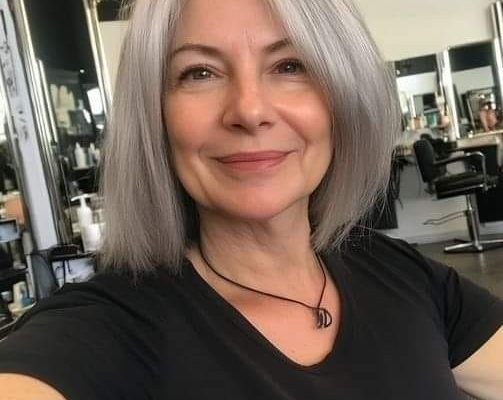When my wife recently went to the salon, I expected her to come back with her gray hair dyed, as she usually did. Throughout the years, more and more silver strands had appeared, and I’ll admit, it troubled me. I wanted her to look “young” and vibrant, but she had different plans.
When she shared a selfie after her appointment, I was taken aback—her gray hair was still there. At first, I was disappointed and didn’t understand why she would want to keep the gray. However, since that moment, I’ve had a change of heart. It’s not merely about hair; it’s about self-love, acceptance, and a much larger cultural movement.
For decades, women around the world have felt the societal pressure to conceal their gray hair, almost as if aging were a secret they were required to keep. The prevailing norm encouraged dyeing hair to cover up any gray, driven by deep-seated messages that equated youth with beauty and relevance. This expectation was not limited to a specific generation but rather permeated society at large, with industries, advertising, and even family dynamics reinforcing the idea that gray hair somehow lessened a woman’s worth. But, remarkably, times are changing. Across the globe, women are proudly choosing to embrace their natural gray hair, making a statement that goes beyond mere aesthetics. The #GreyHairDontCare trend is not just a popular fashion statement—it’s an empowering movement that’s shaking up long-held beauty standards and encouraging women to embrace their authentic selves.
This shift towards embracing gray hair didn’t happen overnight. Celebrities have played a notable role in normalizing the idea that gray hair can be both beautiful and empowering. Actresses like Andie MacDowell, Helen Mirren, and Jodie Foster have made headlines by confidently sporting their gray locks on the red carpet. These high-profile moments sent a clear message to women everywhere: letting your gray hair show is not only acceptable, it can be utterly stunning. When Helen Mirren stepped onto the red carpet with her silver hair shining under the lights, or Andie MacDowell showcased her silver curls with pride, they weren’t just styling their hair—they were making statements about aging, self-worth, and beauty. These public displays challenge the traditional narrative that youth equals beauty, signaling that a woman’s value doesn’t diminish with age but rather grows with the richness of her experiences.

Social media has further amplified this movement, creating a space where women can share their journeys, support each other, and collectively redefine beauty. Instagram accounts such as @agingwith_style_and_grays and @grey_so_what have gained massive followings by celebrating the beauty of gray hair and offering styling tips, encouragement, and a sense of community. These platforms allow women to break free from conventional beauty expectations and redefine beauty on their terms. The numbers tell the story: on TikTok alone, the hashtag #greyhair has amassed over 470 million views. Clearly, this isn’t just a passing trend; it’s a revolution in how society perceives beauty and aging.
Interestingly, the COVID-19 pandemic catalyzed a shift that no one anticipated. With salons around the world shut down during lockdowns, many women were suddenly unable to maintain their regular dye routines. At first, some tried DIY hair dye kits at home, while others embraced their natural color by default. What began as a necessity quickly transformed into an opportunity for self-acceptance. Without the pressures of social gatherings or workplaces, women experienced a newfound freedom to let their gray hair show. For many, this led to an empowering journey of self-discovery and acceptance. They realized that they didn’t need to conform to a specific image to feel beautiful or valued.
The pandemic-driven shift in beauty standards didn’t end with hair color. It extended to other aspects of personal appearance and self-care, triggering a wider reevaluation of what beauty truly means. Women began to challenge the idea that they must look “young” to be considered attractive or worthy. This reevaluation of gray hair as a beautiful feature rather than a flaw was part of a larger cultural shift towards appreciating natural beauty and authenticity. By embracing their gray hair, women are not only making a statement about aging; they are rejecting the ageist notion that beauty is exclusively linked to youth.
In my own family, I witnessed this transformation firsthand. When my wife decided to keep her gray hair, I initially saw it as a simple aesthetic choice. But as I watched her fully embrace her natural hair, I came to understand that it represented much more. Her decision to go gray was a reflection of her self-confidence and a rejection of the notion that beauty fades with age. Her silver strands became a powerful statement of her life experiences, her resilience, and her worth—qualities that are far more enduring than any hair color. This journey of self-acceptance not only deepened her sense of identity but also allowed her to inspire others around her to embrace their own authenticity.
The rise of the gray hair movement isn’t just about individual choices; it represents broader cultural trends related to self-esteem, confidence, and mental health. Social media has played a critical role in this movement, serving as a platform for gray-haired influencers and advocates to share their stories. These platforms have allowed women to reclaim the narrative around gray hair, reframing it as a symbol of strength and self-acceptance rather than a sign of decline. Influencers such as those behind the @agingwith_style_and_grays Instagram account offer practical advice on styling and caring for gray hair, while also providing emotional support and validation for women on similar journeys. By sharing their stories, these influencers help normalize gray hair in a way that was previously unimaginable.
This cultural shift is not limited to social media; it’s also impacting the beauty industry. For decades, beauty brands have pushed products that cater to the desire to stay youthful, promoting hair dye as a necessity for anyone wanting to appear vibrant and relevant. But with the rise of the gray hair movement, companies are beginning to adjust their messaging. Brands are realizing that there is a growing market of consumers who value authenticity and self-acceptance over conformity. Dove, for example, launched its #KeepTheGrey campaign, which encourages women to embrace their natural color. By focusing on products that enhance gray hair rather than conceal it, the beauty industry is slowly recognizing that inclusivity and diversity in beauty standards are more important to modern consumers than perpetuating outdated ideals of youth and beauty.
The evolving perspective on gray hair can also be seen through academic research. Studies conducted by institutions like the Centre for Appearance Research reveal that perceptions of gray hair are shifting in favor of a more positive outlook. Women in their 40s, 50s, and beyond are now viewed as dynamic and stylish, with gray hair amplifying their confidence. This shift aligns with a broader societal trend toward inclusivity, where different forms of beauty are celebrated rather than restricted to specific ages or appearances. Today, gray hair is seen as a reflection of wisdom, strength, and authenticity, qualities that resonate with a world increasingly valuing individuality over uniformity.
The potential impact of this movement extends beyond just women embracing their gray hair. It opens up new conversations about how we view aging in general. For years, societal pressures have led many people to hide signs of aging, from wrinkles to gray hair, as if these natural processes were flaws to be corrected. But as more people embrace their gray hair, they’re challenging the narrative that aging is something to be hidden or avoided. This movement serves as a reminder that beauty is not about looking a certain way but about embracing who you are. Gray hair, once considered a marker of aging, is now celebrated as a unique and beautiful aspect of an individual’s appearance.
In my initial reaction to my wife’s choice, I mistakenly thought her decision to keep her gray hair was purely superficial. But I now realize that her choice is far deeper. It represents a confidence that comes from knowing her value isn’t diminished by a few gray strands but rather amplified by them. Her decision reflects a rejection of societal expectations and an embrace of her authentic self. Each silver strand is a testament to her life’s journey, her experiences, and her resilience—a message that beauty doesn’t fade with time; it evolves.
For anyone considering the transition to gray hair, remember that beauty isn’t about conforming to societal standards. It’s about celebrating who you truly are. Embracing gray hair can be a powerful act of self-acceptance, one that radiates confidence and authenticity. Whether you choose to dye your hair or let it go gray, the decision should come from a place of self-love rather than societal pressure.
The gray hair movement has inspired countless individuals to redefine their perspectives on beauty, aging, and self-worth. It serves as a reminder that each person’s journey is unique, and beauty is not confined to a single standard. For those who choose to let their gray hair shine, it’s more than just a style—it’s a celebration of life, resilience, and the beauty that only grows with time.
As society moves towards more inclusive definitions of beauty, gray hair stands as a symbol of authenticity and empowerment, challenging the outdated ideals that have shaped beauty standards for so long. By embracing their gray hair, women around the world are boldly stating that they are beautiful at any age and on their own terms. This movement, while rooted in something as simple as hair color, represents a profound shift in cultural values—one that celebrates aging as a journey of strength, wisdom, and self-acceptance. Gray hair is no longer something to hide; it’s something to celebrate, and it’s here to stay.


